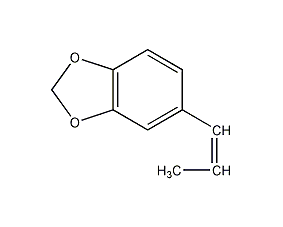
Structural formula
| Business number | 03CH |
|---|---|
| Molecular formula | C10H10O2 |
| Molecular weight | 162.19 |
| label |
4-propenyl-1,2-methylenedioxybenzene, isosafrole, isosafrole, isosafrole, 5-propenyl-1,3-benzodioxin, Isosassafras (oil) (cis and trans mixture), Isosafrole (cis + trans), 3,4-methylenedioxy-1-propylenebenzene, 1,2-(methylenedioxy)-4-propenyl-benzen, 1,2-Methylendioxy-4-propenylbenzol, 3,4-(Methylenedioxy)-1-propenylbenzene, 3,4-(methylenedioxy)propenylbenzene, 3,4-Methylenedihydroxy-1-propenylbenzene, 3,4-methylenedioxy-1-propenylbenzene, 4-Propenyl-1,2-methylenediox, spices, essence |
Numbering system
CAS number:120-58-1
MDL number:MFCD00005838
EINECS number:204-410-2
RTECS number:DA5950000
BRN number:82640
PubChem number:24859803
Physical property data
1. Properties: Colorless oily liquid, the product is a mixture of cis and trans isomers. 2. Relative density: 1.117~1.1203. Refractive index: 1.5764. Flash point (℃): 985. Boiling point (ºC): 2536. Solubility: easily soluble in organic solvents such as alcohol, ether, benzene and acetone, and difficult to dissolve in water. .
Toxicological data
1. Acute toxicity: Human LD50: 47mg/kg/1W-I
Rat oral LD50: 1340mg/kg
Mouse oral LD50: 2470mg/kg
Mouse peritoneal cavity LD50: 324mg/kg
Mouse subcutaneous LD50: 1030mg/kg
Rabbit intravenous injection LD50: 300mg/kg
2. Other multiple dose toxicity:
Rat oral TDLO: 26250mg/kg/15W-I
Rat peritoneal cavity TDLO: 450mg/kg/3D- I
3. Tumor-causing: Oral TDLO in mice: 61g/kg/81W-C
Ecological data
None yet
Molecular structure data
1. Molar refractive index: 48.30
2. Molar volume (cm3/mol): 141.5
3. Isotonic specific volume (90.2K): 365.5
4. Surface tension (dyne/cm): 44.4
5. Dielectric constant:
6. EvenPolar distance (10-24cm3):
7. Polarizability: 19.14
Compute chemical data
1. Hydrophobic parameter calculation reference value (XlogP): 3.1
2. Number of hydrogen bond donors: 0
3. Number of hydrogen bond acceptors: 2
4. Number of rotatable chemical bonds: 1
5. Number of tautomers:
6. Topological molecular polar surface area (TPSA): 18.5
7. Number of heavy atoms: 12
8. Surface charge: 0
9. Complexity: 117
10. Number of isotope atoms: 0
11. Determine the number of atomic stereocenters: 0
12. Uncertain number of atomic stereocenters: 0
13. Determine the number of chemical bond stereocenters Number: 1
14. Number of uncertain chemical bond stereocenters: 0
15. Number of covalent bond units: 1
Properties and stability
1. Basic properties
Colorless liquid. Commercially available products are mixtures of cis and trans forms. Has anise smell. Soluble in ethanol, ether and benzene.
Storage method
Packaging in galvanized iron drums or glass bottles. Store in a cool and dry place. Keep away from fire and heat sources.
Synthesis method
Obtained from the isomerization of safrole. The reaction formula is as follows:
Take water-free safrole, heat it in KOH-anhydrous alcohol solution for isomerization, and distill it to obtain isosafrole, with a yield of up to 98%. The presence of moisture is detrimental to the isomerization reaction.
Purpose
Can be used to prepare soap fragrance.

 微信扫一扫打赏
微信扫一扫打赏

